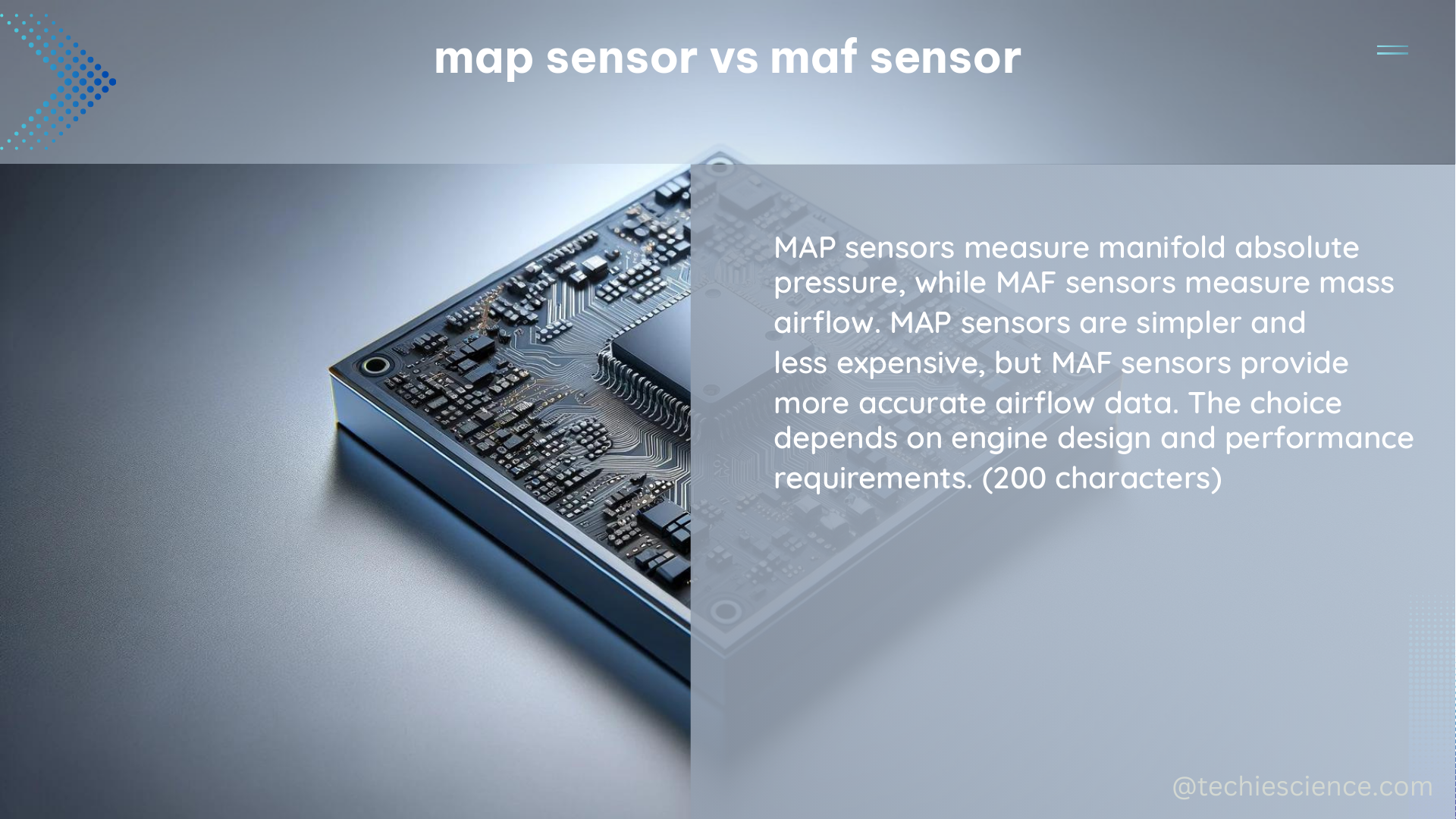MAP (Manifold Absolute Pressure) and MAF (Mass Air Flow) sensors are two critical components in modern automotive engines, responsible for providing crucial data to the engine control unit (ECU) for efficient fuel delivery and engine management. Understanding the differences between these sensors is essential for proper diagnosis and maintenance of your vehicle’s performance.
Principle Mechanism
MAP Sensor:
The MAP sensor measures the absolute pressure inside the intake manifold, which is then used to calculate the engine’s airflow. It is typically located within the intake manifold and measures vacuum, throttle position, and intake air temperature. The ECU then calculates the engine’s airflow based on these measurements.
MAF Sensor:
The MAF sensor, on the other hand, directly measures the mass of air flowing into the engine. It is positioned inline with the intake system, just after the air filter, and provides a direct measurement of the air mass. Some MAF sensors also include a thermosensitive element to measure air temperature, which is useful for determining air density.
Advantages and Disadvantages

MAP Sensor Advantages:
– Located closer to the throttle body, providing a more accurate measurement of air entering the intake manifold.
– Accounts for both negative pressure (vacuum) and positive pressure (possible leaks, alternative intakes, or an open throttle), delivering more comprehensive data.
MAP Sensor Disadvantages:
– May not be as accurate in measuring airflow in high-performance engines or those with forced induction (turbo or supercharger), as they do not account for positive pressure down the line.
MAF Sensor Advantages:
– Directly measures the air mass, providing a more accurate measurement of the actual airflow into the engine.
– Responds accurately to denser air, as more air molecules will cool the wire more, and the MAF will always respond accordingly.
MAF Sensor Disadvantages:
– May not be as effective in high-altitude conditions, as the air density decreases with altitude, and the sensor may not accurately measure the reduced air mass.
Repercussions of Going Bad
When either a MAP or MAF sensor goes bad, it can cause various issues, including:
– Rough engine running
– Stalling
– Low power
– Black smoke from the exhaust
These problems arise because the ECU is delivering fuel based on inaccurate airflow data from the faulty sensor.
Symptoms of a Failing Sensor
To determine if a MAP or MAF sensor is going bad, look for the following symptoms:
– Check Engine Light (CEL) codes related to the sensor’s system
– Rough engine running
– Stalling
– Low power
– Black smoke from the exhaust
Technical Specifications
MAP Sensor Specifications:
– Pressure range: 0-50 psi (or higher, depending on the application)
– Accuracy: ±1% to ±3% full scale
– Response time: 10 ms to 50 ms
– Temperature range: -40°C to +125°C
MAF Sensor Specifications:
– Airflow range: 0-1000 g/s (or higher, depending on the application)
– Accuracy: ±2% to ±5% full scale
– Response time: 10 ms to 50 ms
– Temperature range: -40°C to +125°C
DIY Testing
Testing a MAP Sensor:
To test a MAP sensor, you can use a multimeter to check the voltage output at different pressure points, comparing it to the manufacturer’s specifications.
Testing a MAF Sensor:
For a MAF sensor, you can use an oscilloscope to measure the voltage output and compare it to the manufacturer’s specifications.
Conclusion
In summary, MAP and MAF sensors play crucial roles in modern engine management systems, but they operate on different principles and have their own advantages and disadvantages. Understanding the differences between these sensors is essential for proper diagnosis and maintenance of your vehicle’s performance. By following the technical specifications and testing procedures outlined in this guide, you can effectively identify and address any issues related to these critical components.
References:
- Spark Plugs – MAP vs. MAF: What’s the Difference?
- Mechanics Stack Exchange – What is the difference between a MAP and a MAF sensor?
- NAPA Know-How – MAP Versus MAF: What’s the Difference Between These Sensors?
- YouTube – MAP vs MAF Sensors – How They Work and the Differences
- Bob Is The Oil Guy – MAF vs MAP

The lambdageeks.com Core SME Team is a group of experienced subject matter experts from diverse scientific and technical fields including Physics, Chemistry, Technology,Electronics & Electrical Engineering, Automotive, Mechanical Engineering. Our team collaborates to create high-quality, well-researched articles on a wide range of science and technology topics for the lambdageeks.com website.
All Our Senior SME are having more than 7 Years of experience in the respective fields . They are either Working Industry Professionals or assocaited With different Universities. Refer Our Authors Page to get to know About our Core SMEs.